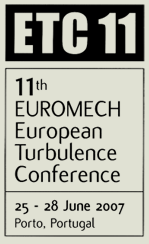Speakers
Progress in Large Eddy Simulation modeling of temporally and spatially complex land-atmosphere interactions
C. Meneveau(1), S. Chester(1), V. Kumar(1) and M. B. Parlange(2)
(1) Center for Environmental and Applied Fluid Mechanics, Johns Hopkins University, Baltimore, USA.
(2) School of Architecture Civil and Environmental Engineering, EPFL, Lausanne, Switzerland.
Large Eddy Simulation (LES) of the atmospheric boundary layer (ABL) is used to study several complex phenomena. First, temporal complexity is considered by simulating an entire daily cycle of the ABL. The simulations use the Lagrangian scale-dependent dynamic subgrid-scale model. The surface boundary condition is derived from the field observations of surface heat flux from the HATS experiment. The simulation results display good general agreement with previous modelling and experimental studies with regard to characteristic features such as growth of the convective boundary layer by entrainment, nocturnal jet and multi-layered flow structure of the nocturnal regime.
To gain a better understanding of the physical parameters affecting the statistics of the flow, we study the dependence of a subgrid parameter (Smagorinsky coefficient) upon atmospheric stability. The profiles of these turbulent variables plotted as a function of Obukhov length show "hysteretic" behavior that implies non-unique dependence (Kumar et al. 2006., to appear in Water Resources Research). Secondly, spatial complexity is considered by simulating flow over multi-scale, fractal-like, objects. Fractals display large scale-disparity and complexity while being amenable to simple and standardized description. Hence, they offer an elegant idealization of the actual interactions between turbulence and boundaries in practical applications where boundaries are characterized by multiple length-scales. First, using LES of flow over prefractal shapes with increasing numbers of branch generations, the dependence of the tree drag on the inner cutoff scale of the fractal is studied.
It is found that the convergence of the drag coefficient towards a value that is independent of inner cutoff-scale is very slow. In order to address this fundamental difficulty and avoid the need to resolve all the small-scale branches of the fractal, a new numerical modeling technique called Renormalized Numerical Simulation (RNS), is introduced. RNS models the drag of the unresolved geometry elements using drag coefficients as measured from the drag forces generated by the resolved branches and unresolved elements as modeled in previous iterations of the procedure. The RNS technique and its convergence properties are tested by means of a series of simulations using different levels of resolution. Then, RNS is used to investigate the influence of the tree fractal dimension on the drag coefficient (Chester et al. 2006, submitted to J. Comp. Phys.).
| © 2006 ETC11 | http://etc11.fe.up.pt | etc11@fe.up.pt |
